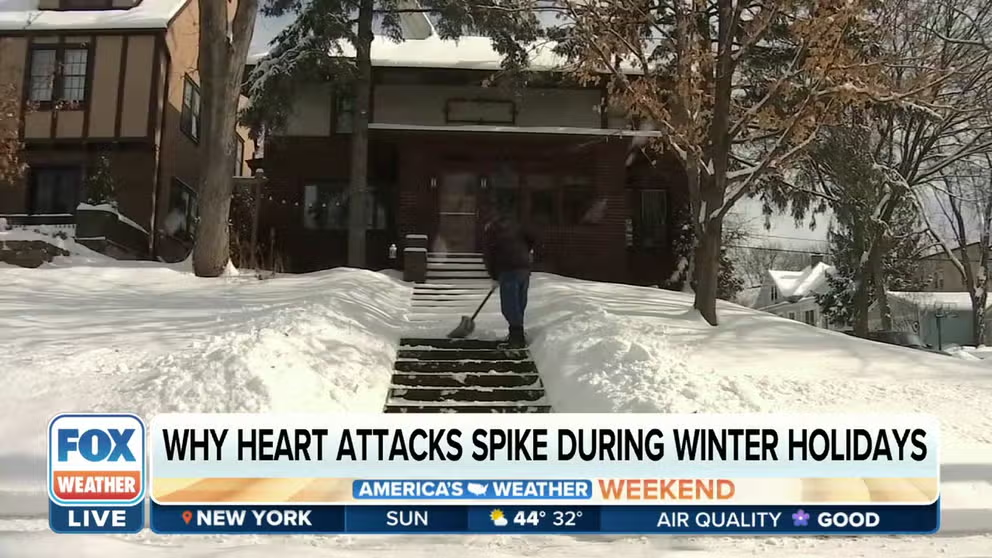How to save a life during the deadliest week of the year for cardiac arrest
Hands-only CPR can be the difference between life and death when someone suffers a heart attack, it's easy to learn and simpler than traditional CPR.
Why heart attacks spike during winter holidays
Dr. Mitch Elkind tells us which 3 days of the year see the most heart attacks and why.
‘Tis a dangerous time of year. According to the American Heart Association, more people die from heart attacks during the last week of December than at any other time of the year.
Christmas Day tops the list, followed by the day after Christmas and New Year’s Day, according to the health group.
"We see every year during the winter months, in the cold months, that there's about a 10% or more increase in the rate of fatal cardiovascular events – things like heart attacks and cardiac arrest when the heart stops beating altogether," Dr. Mich Elkind, Chief Clinical Science Officer for the American Heart Association told FOX Weather. "On top of that, right at Christmas and New Year's, there's a further, about 5%, increase in risk of those events."
THE 3 MOST LIKELY DAYS TO DIE OF A HEART ATTACK ARE DURING THE HOLIDAYS
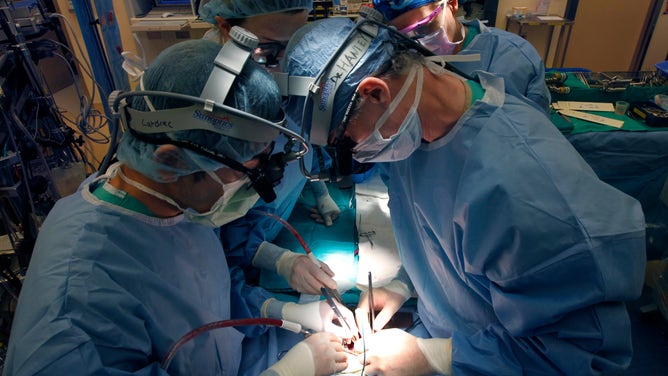
A cardiac surgeon Dr. performs open-heart surgery on a patient.
(Paul Chinn/The San Francisco Chronicle / Getty Images)
He suggested a main driver for the uptick is that people are less likely to seek medical attention during the holidays.
You can start to turn those statistics around by knowing how to perform CPR.
What is cardiac arrest?
Every second counts when someone’s heart stops. Every minute CPR is delayed, the victim's survival rate decreases by 10%, according to Mayo Clinic Emergency Physician Dr. Robert Hyde. The National Institute of Health reported that nine out of 10 people who have a cardiac arrest away from a hospital die, often within minutes.
"We say time is muscle when we're talking about heart attacks," Hyde said.
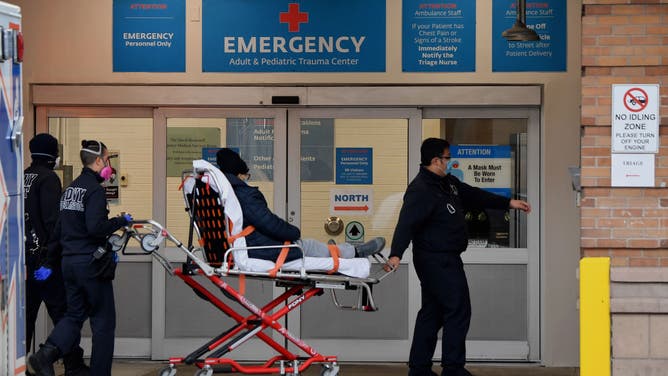
Healthcare workers transport a patient from an ambulance to a hospital in New York City.
(ANGELA WEISS/AFP / Getty Images)
Cardiac arrest occurs when the heart stops pumping unexpectedly. One reason could be a heart attack which is when blood flow to the heart is blocked or severely reduced, according to the Mayo Clinic.
Chest compressions, which are part of CPR, continue to move blood through the body even though the heart muscle can't pump it. Muscles and organs, like the brain, need oxygen and nutrients supplied by blood to survive.
"Every minute that goes on where the brain's not getting oxygenated blood becomes a significant mortality risk factor and patients not having good neurological outcome," he added. "That's another really significant issue with patients that have cardiac arrest that don't get CPR."
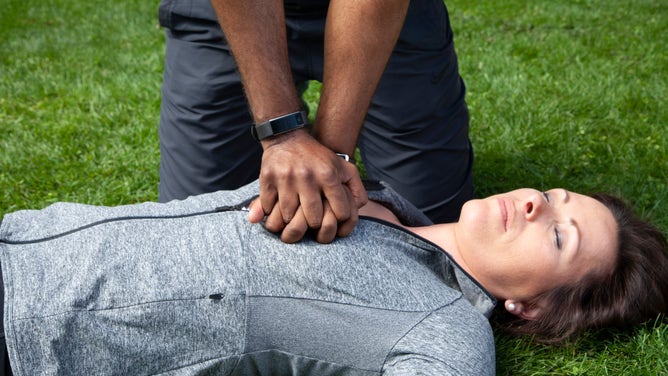
Two actors demonstrating CPR.
(American Heart Association / FOX Weather)
The less complicated hands-only CPR can save a life
"There's a lot of people that do not want to perform mouth-to-mouth," said Hayes of the traditional method of CPR.
Some people find the process hard to remember: 30 chest compressions at 100 to 120 compressions per minute, then two rescue breaths while holding the victim's nose and tilting the chin.
More people are also understandably skittish about putting their mouths on a stranger after the COVID-19 pandemic.
Most people can perform hands-only CPR: Push hard and fast in the center of the victim’s chest at a rate of 100 to 120 beats per minute. American Heart Association research shows that Americans are more likely to remember the correct rate when trained to the pace of disco classic "Stayin’ Alive," which is about 100 beats per minute.
JANUARY MARKS PEAK OF CARDIOVASCULAR-DISEASE DEATHS AND NOT JUST BECAUSE WE'RE SHOVELING SNOW
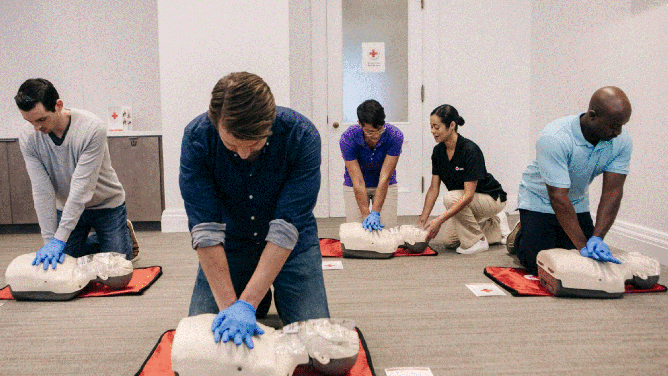
The Red Cross conducts free CPR classes.
(Dennis Drenner/American Red Cross / FOX Weather)
Research shows that more bystanders will attempt to save someone’s life with hands-only CPR versus full CPR. After the state of Arizona ran an educational campaign about the hands-only version, the number of people attempting CPR went from 28% to 40% in just four years, according to a study published in the Journal of the American Medical Association.
The same study, despite having a small sample size, showed an encouraging 13% survival rate of victims who received hands-on CPR. About 8% of victims receiving traditional CPR survived.
According to the American Heart Association, 70% of all out-of-hospital cardiac arrests happen at home. The person that you save could be sitting at the family’s holiday dinner table.
"Starting CPR immediately and calling 911 could be the difference in life or death in those situations," Elknid said. "Hands-only CPR is something nearly everyone can learn and do."
It's easy to get CPR training
Save a life with hands-only CPR
The American Red Cross developed this video demonstrating hands-only CPR.
The Red Cross offers a quick online video and has links to local in-person classes on CPR that do not include mouth-to-mouth.
Local hospitals, police stations and fire departments also offer classes and information.
The American Heart Association has also set up training kiosks across the country and a website to locate the one nearest you.
THE 7 P'S OF COLD WEATHER SAFETY
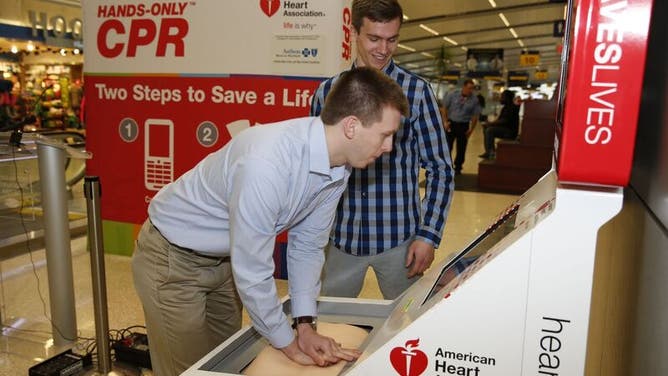
Kiosks across the U.S. including airports offer a 5-minute tutorial and practice.
(American Heart Association / FOX Weather)
"Get trained for the moments that matter," said Dan Lauritzen, spokesman for the American Red Cross. "It’s important for people to know what to do in an emergency. Red Cross first aid and CPR classes take just a few hours and are recommended for everyone, including parents, grandparents and caregivers."
The American Heart Association also offers an online tutorial for CPR, including an AED or Automated External Defibrillator. AED boxes can be found in most public places such as shopping malls, courthouses and schools.
"The machines and the technology are now so advanced that really all you have to do is bring the machine to the patient, open up the lid, and then the machine will guide you through the steps of where to put the pads and when to start CPR and when to stand back so that a shock and be delivered," Hyde said. "So, it's automated in that sense."
HOW TO WATCH FOX WEATHER ON TV

Kiosks across the U.S. including airports offer a 5-minute tutorial and practice.
(American Heart Association / FOX Weather)
The Red Cross also offers a First Aid Application for people and pets for your mobile device. Check it out for warning signs of cardiac arrest or tips on treating minor emergencies your family may have during the holidays. You can even ask your Alexa device to "enable First Aid by American Red Cross" for hands-free info.
